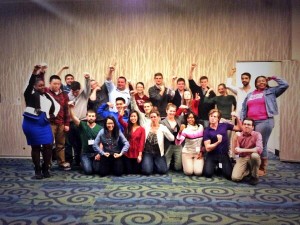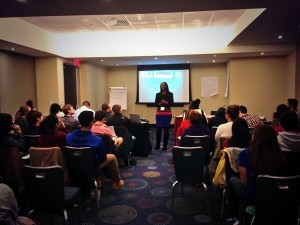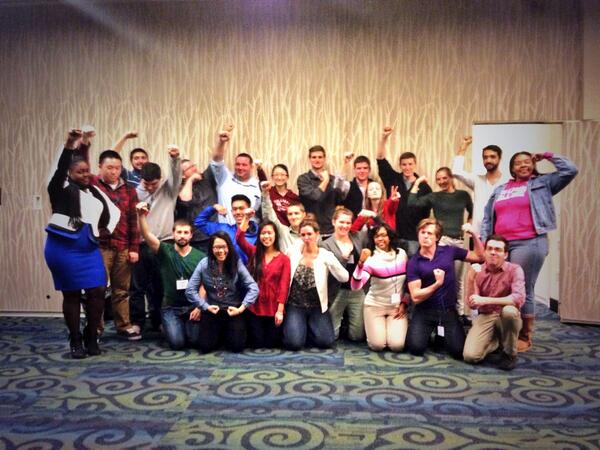Originally posted at: thegenynot.com
Written by Dorthea Thomas
 When it comes to environmental justice, it’s about ensuring low-income, communities of color have equal access to clean air, water, and land. Environmentalism, sustainable development, and labor are apart of the solutions to make the possibility of a better future for generations to come a reality. The inaugural Youth Climate Caucus, sponsored by NRDC and Blue Green Alliance, brought together youth from groups from labor, justice and environmental movements to network, learn, and build alliances to build healthy sustainable communities together.
When it comes to environmental justice, it’s about ensuring low-income, communities of color have equal access to clean air, water, and land. Environmentalism, sustainable development, and labor are apart of the solutions to make the possibility of a better future for generations to come a reality. The inaugural Youth Climate Caucus, sponsored by NRDC and Blue Green Alliance, brought together youth from groups from labor, justice and environmental movements to network, learn, and build alliances to build healthy sustainable communities together.
The Youth Climate Caucus, apart of BGA’s annual Good Jobs, Green Jobs conference, was an event catered to giving youth an opportunity to build authentic relationships and play a bigger role in solving our rapidly worsening climate crisis. It’s not very often that you hear about the intersection of labor unions, social justice groups or environmental organizations working together for a specific issue or cause. But a new generation of leadership is growing to appreciate the collective power of solidarity.
Dr. Jalonne White- Newsome , Federal Policy Analyst from We ACT for Environmental Justice spoke about the history of the environmental justice movement. The Worker Sanitation Right’s Strike, initiated by Dr. King was the beginning of a movement that connected civil rights, environmental justice, and labor.
 There was a point in our history when sanitation work, to white people, was unclean and beneath them. Therefore the understanding was that only black people worked those jobs because they were the inferior. This led to poor working conditions for sanitation workers who were considered some of the lowest in society.
There was a point in our history when sanitation work, to white people, was unclean and beneath them. Therefore the understanding was that only black people worked those jobs because they were the inferior. This led to poor working conditions for sanitation workers who were considered some of the lowest in society.
Because communities of color were segregated, often times those were the areas that sanitation was at its worst. The living conditions were often hazardous, where many black people were in danger of disease. When chemicals were dumped, they were usually dumped in areas where people of color lived. Not only were black people living in these dangerous environments, but they were also the workers all over cities to clean waste. Our past was not pretty and the social justice movement was a dirty place to be in.
Fast forward to our future and we now still see an ever- growing trend. Low-income neighborhoods, communities of color, and tribal areas suffer environmental burdens like contamination from industrial plants or landfills and indoor air pollution from poor housing conditions. Some neighborhoods, communities, and regions have become the dumping grounds for all kinds of toxins because of their race and/or class.
However,it’s imperative to note that social justice advocates cannot win this fight alone when it comes to environmental justice. Without the help of environmentalist and labor unions, the environmental justice community is weak and voiceless. We have to not only fight for the health of our communities, but the right to sustainable good jobs and open green clean space to live, work, and play.
As a new generation rises up in leadership, the importance of building solidarity and bridging these intersectional lines will strengthen. Environmental Justice means equal access for clean, healthy, and sustainable communities for all. Now, what would the movement be without ensuring justice is served for better health, sustainable jobs, and a cleaner environment for generations to come?
We are the future.
 Miss Dorthea E. Thomas is a renowned public speaker, poet, and social entrepreneur with a passion to inspire youth. She’s the Founder of The Minority Women in Leadership Commission, a not-for-profit group dedicated to mentoring and empowering young women and girls to increase their leadership capabilities. Currently she works for Detroit Public Schools District in the Office of Energy & Sustainability as an Americorps Green Schools Coordinator with EcoWorks. She attended C2C UMich 2013.
Miss Dorthea E. Thomas is a renowned public speaker, poet, and social entrepreneur with a passion to inspire youth. She’s the Founder of The Minority Women in Leadership Commission, a not-for-profit group dedicated to mentoring and empowering young women and girls to increase their leadership capabilities. Currently she works for Detroit Public Schools District in the Office of Energy & Sustainability as an Americorps Green Schools Coordinator with EcoWorks. She attended C2C UMich 2013.

